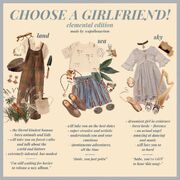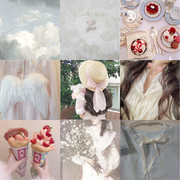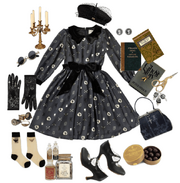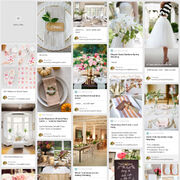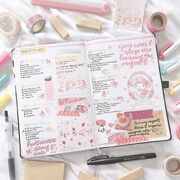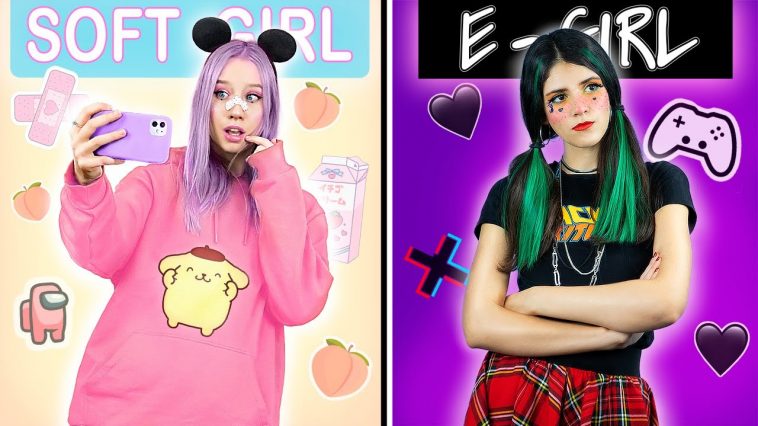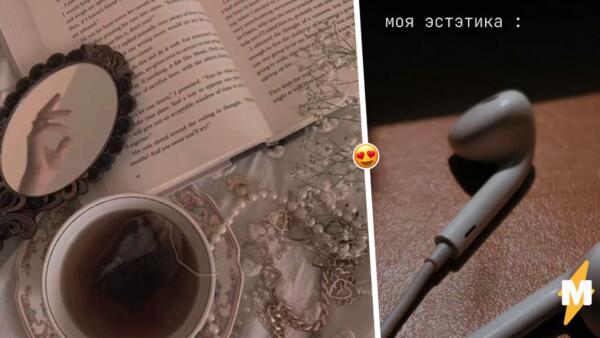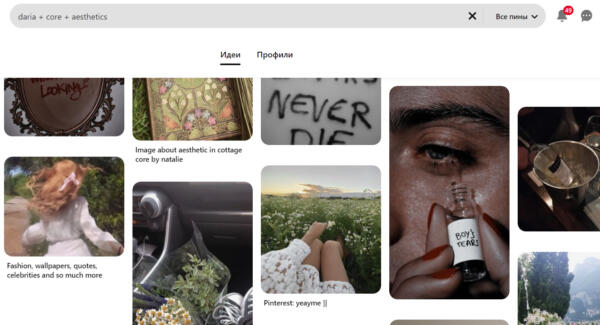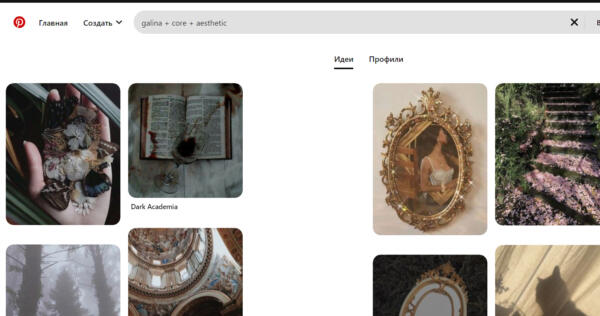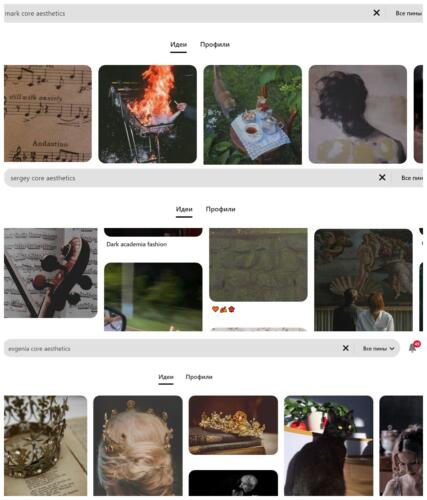Как определить свою эстетику
Ежедневно мы задействуем разные виды интеллекта: речевой, эмоциональный, логико-математический и творческий. Но есть еще один – эстетический, который выражается в умении по-своему видеть и понимать красоту. Вместе с Ювелирным Домом Kabarovsky предлагаем тебе пройти тест и выяснить, какая эстетика тебе больше всего подходит. А еще подскажем, что стоит надеть, чтобы максимально приблизиться к ее воплощению.


Как проходят твои идеальные выходные?

Костюмированная вечеринка в дружеской компании до самого утра. Ради этого можно даже снять помещение с атмосферными декорациями
Поездка в горы. Свежий воздух, обилие зелени и ароматный травяной чай – вот, что точно меня взбодрит
Вкусная еда и сериалы до самого вечера – тоже отличная идея
Пикник на пляже или в парке на пару со вкусными десертами, фруктовым вином и интересной книгой
Вечер на главной улице города. Буду гулять, заглядывая в бары и магазины, или затеряюсь в парке с аттракционами
дальше

На какой коктейль походит твой темперамент?

Кровавая Мэри. Это классика
Беллини – просекко с сахарным сиропом, лимонным соком и персиковым пюре. Вкусно, женственно и сексуально
Виски-кола – лучшее сочетание для веселой вечеринки
Манхеттен на бурбоне, красном вермуте и биттере
Нежный и пряный мятный джулеп
дальше

Какой аромат выберешь?

Табак, ваниль, перец, кожа и ром
Роза, кокос, сандал, пачули и мускус
Цитрусы, пачули, мускус и карамель
Ветивер, сандал, ладан и ваниль
Кленовый сироп, бобы тонка и анис
дальше

Какой фильм ты бы сейчас посмотрела?

«Другой мир», «Сайлент Хилл», «Заклятие» — всем жанрам предпочитаю ужасы
Ромком или мелодраму — мне нравятся фильмы о любви
Любой комедийный. Обожаю фильмы с Джимом Керри, Адамом Сендлером и Мелиссой МакКарти
Боевик или приключения. Наверное, пересмотрю «Мумию». Хочется увидеть смелых и авантюрных героев, которым все по плечу
Научную фантастику, например «451 градус по Фаренгейту» или «Петля времени»
дальше

Какой твой любимый цвет?

дальше

Какое направление в живописи тебе нравится больше всего?

Меня привлекает напряженность сюжета и обилие темных оттенков, поэтому я выбираю готику
Ничего не имею против романтизма. Мне импонирует эмоциональность картин, реалистично изображающих страх, ужас и сильное волнени
Обожаю поп-арт: яркие цвета, броские формы и силуэты, юмор и легкость в подходе к изображению
Люблю классическое искусство: портреты, пейзажи и натюрморты
Что может быть интереснее сюрреализма? Картины Сальвадора Дали, Макса Эрнста и Рене Магритта – тому подтверждение
дальше

Что обязательно должно быть в твоем доме?

Барный шкафчик с для веселых посиделок с друзьями
Мини-сад с красивыми цветами и пряными травами
Место для занятий танцами, йогой и медитацией
Полноценная гардеробная с красивыми платьями и туфлями
Технологичная кухня: венскому шницелю и йоркширскому пудингу без этого не бывать
дальше

Что чаще всего выкладываешь в Instagram?

Необычная архитектура, особенно готическая
Конечно же, себя. Чаще всего это удачные селфи либо фото с интересными луками и аксессуарами
Редко публикую новые посты, если это не фото с выставок
Еда и интерьеры. Такие фото выглядят стильно, их хочется рассматривать и восхищаться
Морские и горные пейзажи. 80% моих фотографий – это снимки из путешестви
дальше

Совет по стилю
To define is to limit. -Oscar Wilde
This page includes a loose set of tips, guidelines, and disclaimers intended to help users develop and find their aesthetics. It includes the opinions and advice of the Aesthetics Wiki administrators and moderators. The recommendations and processes documented here are neither objective nor authoritative, and are intended to be suggestions, not requirements. Because this process is subjective and has no set time limit, process, or rules, nobody needs to follow these guidelines and should not only consult the contributors of this wiki, but also look into real-life events and locations, media, influential people, and peers. This article can be interpreted chronologically, but different steps could and should be skipped, revisited, or constantly worked on.
What is “Having an Aesthetic?”
Having an aesthetic means identifying with an aesthetic in visual and personal expression. A person that identifies with a certain aesthetic would have a style of dress, taste for interior design, preferred media, and/or blog that carries across certain visual similarities that have different connotations.
There are many levels of “having an aesthetic,” and what it entails differs from opinion to opinion. Some ways of having an aesthetic includes:
- Running a blog (typically on tumblr) that posts and reblogs aesthetic content that is consistent with a community or the user’s own unique aesthetic.
- Having a fashion style that is distinctive and predictable
- Following a certain stereotype or subculture
Disclaimers
While some of these may seem trite and self-evident, keep in mind that many people are on this wiki to find themselves and are generally inexperienced with the community. Many assumptions have been made due to the hyper-categorical “cliques” that have arisen due to the presence of “choose one” memes, self-identifications, and influencers that have specific niches. Therefore, it is necessary to have this list to dispel any assumptions.
- You don’t need an aesthetic. There are billions of people who do not concern themselves over moodboards, playlists, or outfits. Most people in life simply adhere to their society’s opinions on what is acceptable or not. You do not have to look for an aesthetic to assume or try to learn about anything in this wiki if you do not want to. This is an unessential subculture of the Internet, rather than a mandatory skill to have.
- You can appreciate an aesthetic without incorporating it into your daily life. Because of career obligations, monetary limitations, and lifestyle/personality differences, it is completely okay to not live like your aesthetic. Making moodboards, participating in discussion, and fantasizing is perfectly acceptable and you are not lesser than others because you do not actively wear/do the activities the aesthetic has.
- You can have more than one aesthetic, pick and choose from multiple aesthetics, and even leave your aesthetic unnamed. Shoehorning yourself into a single label limits you and will make you less willing to explore other aesthetics and assume aspects of them that would bring you happiness. However, some aspects of aesthetics are non-negotiable, and it is best to experiment and understand the fundamentals if you choose to blend different aesthetics together.
- Aesthetics can take decades to develop. The whole aesthetic journey is a process that is constantly limited by money, responsibilities, and environment. You need to take time to research, acquire objects, and evolve your aesthetic. There is no end-point where you are going to feel completely satisfied and match the paragon of a community.
- You could (and should!) move on from an aesthetic and evolve if you feel unsatisfied and drawn to something else. See the sunk-cost fallacy. The entire point of aesthetics is to be a source of happiness, and even if you feel like being in your old community is safer and does not require research, new items, or new communities, you will have regret in the long run.
- Not everything in your life has to be aestheticized. Because of the popularity of social media photography, many people assume that their peers live in idealized worlds that match their aesthetic exactly. In truth, many, if not most things should have their practicality placed above whether or not they fit your imagined lifestyle.
- Aesthetics are not a race. While there is definitely a fear of missing out and a desire to not waste time, trying to assume an aesthetic as quickly as possible (shopping hauls, consuming only one type of media, etc.) is not something you need to do. In fact, not taking the time to experiment can in fact lead to wasted money, time, and a lack of knowledge on other available aesthetics.
- Assuming a new aesthetic will not magically change your personality, habits, or mental state. You either have to work for them if you aspire to have those traits or you should not try to have them if you do not want to. For example, you can buy all of the highlighters you want, but until you actually use them to take notes, you are not Studyblr. Choosing to be Cottagecore does not mean you have to abandon sarcasm and swearing. Likewise, you do not have to base your aesthetic on personality traits that you have, as those two are independent of each other. Aesthetics are not a reflection of the personality and personality is not a reflection of aesthetics.
- Your physical appearance is independent from your aesthetic. While cultural background does influence your choices, you do not have to pick up or drop an aesthetic because of your race, gender, weight, and age. This is especially true for ethnicity, as people assume that only people of a certain race can participate in an aesthetic. While some races show more in photographs (largely because of the Western standard of beauty), it does not matter. If your gender and weight are not typical, some aspects do have to be changed in fashion, such as tailoring, being unable to wear certain garments, etc. However, this does not make you any lesser than your peers.
- Opinions on authority are different in every aesthetic community. The opinion of whether or not some people have more knowledge and should be listened to is debatable. Anyone can choose whether or not to adhere to guidelines, ways of thinking, or listen to on authority within the community. However, there are definitely right and wrong ways to participate in aesthetic communities. Some have very strict guidelines on what constitutes the aesthetic, what objectively looks good, and who should be listened to. This is especially true in communities that have been antagonized, are based on a strict definition, or are inherently political/musical/etc. Trying to not listen to people who have more experience in these communities will get you justifiably shunned. You should gauge whether or not you are willing to humble yourself and listen, or if that social environment is not for you and should instead assume a derivative aesthetic.
- Aesthetics cost money. But the amount varies on which aesthetic. For example, Punk, Hippie and Weirdcore fashions are definitely based on thrifting or DIY. “Mid-range” aesthetics like Dark Academia would also still need a fair amount for money, so expect to save some. This is especially true in expensive aesthetics such as Boujee and Lolita. Do not cut corners and purchase replicas, shoplift, or steal in order to achieve your aesthetic. There is no shame in saying that you cannot afford something or that you are going to buy it later. Also note that indie brands are NOT rich capitalists that are commercializing aesthetics. Clothing and art take hours to make; the prices reflect that and are fair to the employees.
- Do not appropriate a culture. And this does not mean that you should only stick to the aesthetic from your own culture. Rather, this means that you should research, avoid fetishizing and stereotyping, and avoid speaking over people of that culture.
- There is no “better” or “best” aesthetic. Aesthetics are largely subjective and have different purposes that would make them impossible to be judged on a hierarchy.
Top-down vs. bottom-up
There has been debate in the aesthetics community regarding the appropriate approach to finding and developing one’s own aesthetic. There are two main perspectives: the top-down approach, and the bottom-up approach.
Top-down
Through the top-down approach, a person is first made aware of an aesthetic before participating. To use a popular aesthetic for an example, a person who found a blog about Dark Academia and subsequently decided to read The Secret History, enroll in a philosophy course, and buy new clothes would be taking the top-down approach.
The top-down method is newer with the advent of the aesthetic community and the rise of these specific terms, whereas the originators of the aesthetic and the earlier community (pre -core and academia suffixes) generally prefer the bottom-up approach. Please note that these approaches can be combined and negatives can be eliminated with contemplation and planning.
Benefits
- Creates a more coherent and specific vision of your aesthetic. Having a single aesthetic community comes with having guidelines, moodboards, and visual tropes that you do not have to figure out to add.
- Does not clash with your pre-existing interests. You could avoid confusion on whether or not your hobbies, interests, etc. add to your aesthetic.
- Helps you find a community faster. Bonding with others when you’re new on Discord, tumblr, etc. is a good way to make friends who share your interests.
Drawbacks
- Following a pre-established set of guidelines may suppress individuality. You may follow the community’s guidelines instead of developing your own unique tastes.
- You have a greater chance of doing everything in the disclaimer above. This is, however, more of a symptom of contemporary social media rather than specifically due to this approach.
- You might be seen as a “poser.” People, especially the more experienced ones in popular aesthetics, in the community tend to be bottom-up and wish that people develop their own tastes instead of copying them.
Bottom-up
Through the bottom-up approach, a person has interest in various aspects of a preexisting aesthetic, and finds the community for that aesthetic through their interests. To use another popular example, a person who had a light-color, vintage fashion style, cultivated a flower garden, and made baked goods would try to find a name for their aesthetic and stumble onto the Cottagecore wiki page.
Benefits
- Your aesthetics would be tailored more towards your interests and you would feel more secure in your aesthetic community/individual unnamed one because it comes from yourself rather than outside influence.
- You have less of a chance of doing the behaviors that the disclaimers discourage. That section has been made as a response to many behaviors in the top-down method that has become more popular in contemporary social media. In avoiding those, you are avoiding toxic behaviors in the aesthetic community and instead focusing on yourself.
- Others may admire your personal aesthetic and you can become a trendsetter and form a community.
Drawbacks
- The process would be more uncertain and drawn-out, especially if your tastes vary extremely and you are indecisive.
- You might base your aesthetic on your personality, hobbies, and habits, which will be against any aesthetic that has the purpose of expressing another part of yourself, desires that aren’t fulfilled, or aspects of your life that do not need to be aestheticized.
- Depending on whether or not you feel like you could fit into a named aesthetic community, you might not have an online friend group to discuss and express your aesthetic interests.
Many users of the Aesthetics Wiki and online ask for their aesthetic by listing certain visuals they like, garments, songs, media, etc. This is not how aesthetics are known and discovered, and often isn’t helpful in participating in aesthetic culture. This page is under construction.
Finding sources of inspiration
Sources of inspiration is a broad term that includes not only this wiki, but also
- Fiction
- Influencers and celebrities
- Photographs in magazines
- Street-snaps
- Locations
- Hobbies and activities
- Time periods
- Art and architecture movements
- Time of day and year
- Colors
- Foods
A collage by @apollonarium on instagram. This is an example of a character collage, a trope of contemporary instagram aesthetic culture.
It is generally a personal experience and decision in knowing what is part of your aesthetic. We are all naturally drawn to certain inspirations due to our own personal psychology, surroundings, communities, and different ways of thinking. Therefore, it’s best to explore all of the offerings by simply being exposed to what aesthetic possibilities are out there.
The contemporary aesthetic movement is also a good way to find it, although it does generally follow the “top-down” method as described above. Aesthetic influencers are largely on TikTok, Instagram, and tumblr. Simply search up the title of the page in the tags and you will find video moodboards, fashion accounts, and “character” collages. On YouTube, there are more thorough guidelines, playlists with a background set to the aesthetic, and fan-made aesthetic music videos.
One issue that comes from trying to find inspiration is knowing if you genuinely want that aesthetic for yourself or you only find it attractive on other people. We can admire other people’s aesthetic because of their personal philosophy, respect for their uniqueness, romantic/sexual attraction, and society’s ideals of beauty. But, we may not be happy having that aesthetic for ourselves. To understand if you would want to share an aesthetic with someone, it is best to imagine how you would incorporate that aesthetic into your life. Would you feel comfortable doing graffiti if the idea of skipping class gives you anxiety? Comparing what you find joy in to what that the other community enjoys would show if you should assume a new lifestyle or aesthetic. Note that this applies only to an aesthetic that you want to carry out in real life. This is not about fantasies, which do not involve actually doing the activities or purchasing anything.
Another is that you can possibly conflate liking a piece of media’s plot, characters, etc. as liking it for its aesthetic. Because we engage with fiction in a way other than aesthetic appreciation, we might mistake the emotions that we feel as appreciation for the visual aspects. Luckily, there is a simple way to objectively examine if a piece of media. Looking at it only aesthetically through screencaps, descriptive paragraphs, and illustrations would allow you to look at the visual aspects instead of the emotional ones.
Osmosis
Osmosis is the gradual and subconscious learning process done by surrounding yourself with things to aspire to and learn from. As you are exposed to more aesthetics, you have a better grasp on how different images make you feel and what you are drawn to. Then, as you start to be more familiar with the common traits between different aesthetics, you become familiar with what you prefer and how it makes you feel.
This could be done through real-life or through having an aesthetic blog/moodboard/journal, which is explored below.
Making a moodboard, blog, or journal
Moodboards, blogs, and journals are a good way to better understand what visually interests you, how you have grown, what media you like, and helps you track your habits if you choose to be in a more achievement oriented aesthetic like Studyblr. This is the space to place all of the things that inspire/interest you aesthetically. Being able to go back and look at a place for aesthetic purposes would clarify what “your” aesthetic is.
How to create a moodboard
- Finding photos is the first step of making a moodboard. To do so, look up subjects or aesthetics that you like. These can be normal rectangles or a transparent. A transparent is an image that has no background and is typically in the PNG format. These images are typically used for scrapbook-style and outfit moodboards, as they allow for layering, showing the background, and different shapes. One can make a transparent by taking an image and erasing any undesired parts with an art software program. Transparents are also shared on social media and outfit moodboard sites, and are free to use according to the OP’s description. One can simply find them via searching “moodboard transparent” or “PNG” on tumblr or Pinterest.
- Select the photos that you want to use in the moodboard. Commonly, one uses a variety of subjects and different qualities that have similarities and contrasts that fit together pleasingly. The colors of the images create a color palette. Multiple creators base their moodboards on themes such as named aesthetics that would be found on the wiki, characters, periods of history, locations, etc. This is not necessary, but a moodboard typically has a unified vision that is communicated through the images.
- Choose a format. This will be described below.
- Use a computer program or app to play around with the arrangement. These include but are not limited to: Adobe Spark, Canva, LINE Camera, Google Slides, Crello, etc. This is a very free-form and subjective process that requires resizing, cropping, and playing around with the arrangement of images, and finding/deleting any photos as necessary. Negative space is an important element, and how cluttered or far apart the elements are is your decision.
Types of Moodboards
Note: The names of the style of moodboards is unofficial, and is only used for wiki-writing purposes. People do not generally label their moodboards by these names and these categories from observations of online aesthetic culture.
A grid-style moodboard
Grids and columns are the most popular ways to create moodboards. They are a collection of images that are cropped into equally sized rectangles or squares. The two most common formats are a square of three columns and three rows or a long rectangle with two columns and as many rows as the OP sees fit. The user either edits the images to make a moodboard that appears as a single image (such as the one on the left) or uploads the images individually onto a single tumblr post, which automatically places images into a grid. Because of this ease, grids are the most common type on tumblr.
A scrapbook-style moodboard
Digital scrapbook pages use both photos and transparent images and allows for free-form arrangement with different sized photos and subjects. In this method, the user takes a blank page and layers found images and transparents over each other, with how cluttered or empty it is being up to preference.
An outfit moodboard
Outfit moodboards revolve around an outfit, with a few other objects or doodles that would enhance the look of the clothing. This was done on the now-defunct website Polyvore[1], but the community has now scattered into different websites that could be found here. These moodboards are more fashion-based and depend entirely on transparent images to allow for layering and cohesion. The original purpose of these moodboards is also less fantasy-based, with many people and sites using this method as a way to document clothes that they already have or are going to buy.
Character collages are like outfit moodboards in that they revolve around transparent images of clothing and other items, but they contain added text that conveys personality traits, habits, and conditions that would be in bullet points, sentence fragments close to the transparents, or text imposed over the objects. Character qualities would be typically shown through symbolic objects. For example, a character who is fond of gardening would have a watering can in the collage. As mentioned above, this is a common trope in Instagram and Pinterest.
Object collections are mooboards composed of various transparents that do not revolve around an outfit, but rather multiple trinkets associated with an aesthetic. The composition of these moodboards would be more cluttered and often times abstract in comparison to the other forms.
How to create an aesthetic blog
An aesthetic blog is a place to store your inspirations, discuss your aesthetic with other people, and find ideas. The best place for aesthetic blogging is typically image-based websites such as Pinterest, tumblr, VSCO, and Instagram. The video-sharing site TikTok is a popular place to share video moodboards, which are rapid-fire flashing images set to music and aesthetic memes such as outfit showcases.
A pinterest board
Simply search for images and collect them in a board/reblog, and follow people who produce content you like.
Websites such as Pinterest and tumblr allow you to save images created by other people into your own blog, which allows you to create a giant, free-form moodboard like the one on the right. Tags and different boards allow you to separate inspirations for separate aesthetics that you like or have different images for different categories, such as fashion or quotes.
Different blogs may also advertise a Discord or another type of group chat that you can join, which allows you to share your aesthetic and create new friends.
A journal in the kawaii aesthetic.
How to create a journal
There are multiple forms of a journal, and of course there are different ones depending on what the purpose of it is, such as a sketchbook, a pure way to express your feelings, or a way to keep track of life goals such as productivity or health. Of course, this section is going to discuss keeping an aesthetic journal, but you are free to combine it with other journal purposes listed above.
Note that journaling is going to be more expensive than the ones listed above, especially since journal culture promotes having multiple pens, stickers, and stationary. Of course, there are ways to do it cheaply, such as purchasing secondhand, DIY, etc.
- Determine what size, format, and appearance you want your notebook to be. A tiny black Moleskine is going to have a different function and feel from a yolk-yellow spiral notebook the size of your face. Knowing what aesthetic you want ahead of time and your level of commitment is necessary before shopping.
- Decide what you want to include in your journal. How planned out you want it to be depends on your personal preference, and you can add whatever wherever. Some ideas of things to include are:
- Lists such as playlists, bucket lists, and favorite things
- Mementos from travel/daily events such as postcards, menus, and receipts
- Photographs. Polaroids are popular.
- Calendars
- Sketches
- Physical collages made of magazine cut-outs, photos, etc.
- Many more can be found here, here, and here.
- Decorate your journal to what suits your tastes, whether with layers of stickers or just plain handwriting. Some ideas are:
- Washi tape to “secure” boxes of information
- Stickers
- Patterned paper cut into shapes
- Colored paper to write different information on
Identifying Commonalities and Refining
Visual vocabulary and identifying common visuals
A visual vocabulary is a broad term that means having a vocabulary that is able to articulate:
- Colors
- General periods of art history and design periods
- This does not have to be specific, but general descriptors like “classical” and “art deco” are good basics
- Stereotypes of important decades and nations such as the Victorian England and 1950’s America.
- Adjectives that specify the qualitative and emotional qualities
- Some examples of good adjectives are: masculine, geometric, sexy, campy, sweet, etc.
- Materials such as wood, types of fabric, and types of metal
- Design motifs commonly found in different fields such as fashion and architecture
- Some examples include: bishop sleeves, Ionic columns, embroidery, and orchids
The amount of specificity is entirely up to you. Learning an entire dictionary is absolutely unnecessary, and a wide visual vocabulary is a skill that takes time to develop, and is in many cases, unused, but useful when doing specific descriptions or trying to describe your aesthetic in words only. Hyper-specificity (ex: “saccharine” instead of “sweet”) can also limit the amount of search results.
A good visual vocabulary is a good tool for researching aesthetics, finding tutorials for DIYs, and allows you to articulate your aesthetic verbally/textually to other people. After creating your moodboard/blog/journal, you use your visual vocabulary to identify common motifs found within your collection of images.
Identifying a color palette
A color palette is a collection of colors that contrast or compliment each other pleasantly. In many aesthetics, the color palette is one of the most defining features of the aesthetic because of the different color connotations humans associate with them. The Colour Theory page explains color coordination and how to describe different color qualities such as saturation and hue.
The best way to identify a color palette is to grow your visual vocabulary of the different hues of colors. Here, here, and here are good sources for knowing the exact names of different hues, although the average vocabulary is much simpler. Also note that some color names contradict each other. However, the simple idea is to narrow down a general color into a shade or a mix. For example, green can range from neon to dark forest green, but specifying mint/seafoam green means that it is a pastel combination between blue and green.
To pick out colors and create a reference book, a good way to do so is to download a software program with an eyedropper tool, such as this one.
Identifying what colors you are attracted to can give you a good idea of any complimentary colors to add, what new photographic subjects to find, and what should be left out.
Refining your aesthetic
Ater you have a compilation of images and a general idea of what your aesthetic “is,” it’s better to try to maintain the board as one cohesive look. This does not mean that you should get rid of anything that does not fit a named aesthetic, but rather getting rid of stray images that do not fit. You may also have compiled imagery that does not fit together pleasingly, which warrants having two separate aesthetics. For example, having a Vaporwave blog with one or two reblogs of pastel Kawaii images makes the latter stand out too much and ruins the cohesion- either balance it via blending the two aesthetics together or keep separate blogs.
Using the Wiki to search for the name of an aesthetic
If you understand what visuals and characteristics you like, but do not know the name for it, simply use the search bar to help find the name for your aesthetic. The wiki entries include a list of visuals for this reason, and it is highly likely that after searching for a specific object or adjective, the page will appear in the search results. For example, if one admires the look of flip phones, typing “flip phones” will result in McBling and Y2K.
The wiki also has “adjective indexes,” which could be found in the List of Aesthetics. These are lists of aesthetics sorted by common qualities such as “feminine” or “wealthy.” After building up your visual vocabulary, you should be able to identify what traits match the aesthetic and the list will be narrowed down into a manageable size.
Putting a Name to Your Aesthetic
This page is under construction
After you have found different visuals that encapsulate your aesthetic, know what aesthetics they come from (if any), what the source is (helps with identifying decades, artists, and subcultures), and what adjectives they can convey. Apply this to all of your visuals from your moodboard, blog, etc. By the end, you should have a list of words that, in essence, describe your aesthetic.
If the list is fairly short, like if most/all of your chosen visuals match a page on this wiki, then you would most likely belong to that community or a blend of two-three aesthetics that have popular names.
Examples
- Punk ice princess
- Black leather jackets and fluffy white skirts, the feeling of biting cold, the look of icicles, graffiti in blue paint
- 1920s Gothic heroine obsessed with botany
- Botanical encyclopedias, flapper white lace dresses, melancholy jazz, Gothic architecture, silent films, dead roses
- Kawaii Gen Z Gamer
- Elaborate PC set-ups, kawaii lo-fi hip hop music, pink sweatshirts over tennis skirts, late nights drinking boba with friends
What to do after finding your aesthetic
While many people believe that finding their aesthetic is the end of their jouney, this is not true. There are multiple things and activities that one can do after learning about their aesthetic, which are not necessary, but are ways to engage with the community and discover more about yourself.
- Building a wardrobe that matches your aesthetic. See Fashion for how to do so.
- Decorating your living space
- Learning about new hobbies and taking one up
- Discovering new music and media to enjoy
- Joining a Discord server or another group chat to engage with people in your aesthetic community
- Continuing to run and add photos to your blog, journal, or moodboards
- Changing and growing your aesthetic as you see fit
- ↑ https://en.wikipedia.org/wiki/Polyvore
Переключитесь на темный режим, который приятнее для глаз в ночное время.
Переключитесь на светлый режим, который приятнее для глаз в дневное время.
+
Переключитесь на темный режим, который приятнее для глаз в ночное время.
Переключитесь на светлый режим, который приятнее для глаз в дневное время.
Пройди этот тест и узнай, какой стиль в одежде тебе подходит)))
Проголосуйте
Back to Top
Забыли пароль?
Введите данные своей учетной записи, и мы вышлем вам ссылку для сброса пароля.
Ссылка на сброс пароля недействительна или истекла.
Пользователи Сети с помощью имени проверяют, какой стиль им подходит, по версии пинтереста. Для этого парни и девушки добавляют к своему имени суффикс «core» и наслаждаются предложенными фотохостингом подборками эстетичных картинок.
Что за тренд на создание эстетики по имени. Впервые ролики с картинками из сервиса Pinterest, подобранными по имени пользователя, появились в 2020-м. Красивый флешмоб окончательно покорил тикток в 2022 году, когда пикчи по именам стали искать не только англоязычные блогеры, но и жители России и стран СНГ.
В видео авторы показывают, какой вайб и стиль им подходит, по версии пинтереста. Для этого в поисковой строке они добавляют к своему имени суффикс core, который обозначает направление в эстетике.
В тренде с пикчами участвуют также парни. В подборках пользователей можно встретить картинки с депрессивными мотивами, изображения в винтажном стиле и весёлые иллюстрации.
Как определить свою эстетику в пинтерест по имени. Самостоятельно узнать свою эстетику довольно просто. Для начала скачайте приложение Pinterest в AppStore, Google Play или зайдите на сайт сервиса через браузер.
Шаг №1
Зарегистрируйтесь в соцсети через почту или аккаунт в Google. Авторизуйтесь.
Шаг №2
В поисковой строке введите слова по формуле: своё имя + core + aesthetics. Обратите внимание, что имя необходимо написать на латинице. Пример выглядит так:
Платформа без проблем выдаёт результаты по мужским и универсальным именам.
Готово, теперь можно узнать, каким вайбом могут обладать Таня или Артём, по мнению пинтереста.
Ранее Medialeaks рассказал про игру «Он/Она 10, но». В тренде участники задают вопросы о качествах вымышленного партнёра, чтобы оценить его по 10-балльной шкале.
В другом материале Medialeaks можно прочитать, как английский язык Ани Покров попал в пародии. В роликах блогеры коверкают слова, имитируя акцент тиктокерши.
